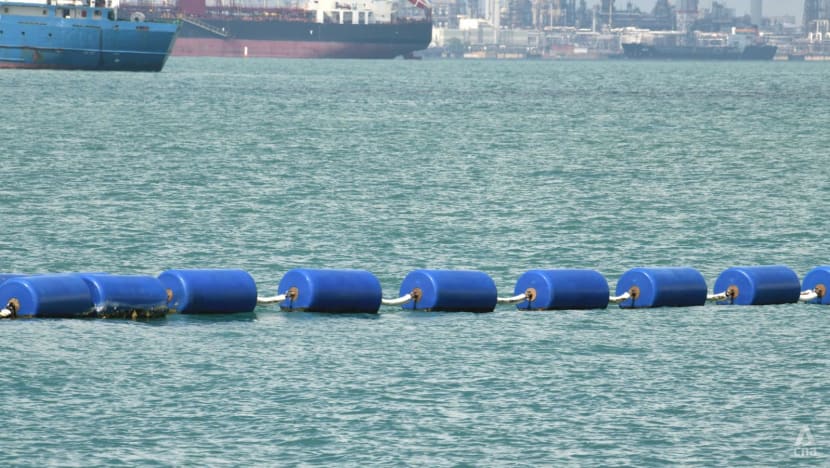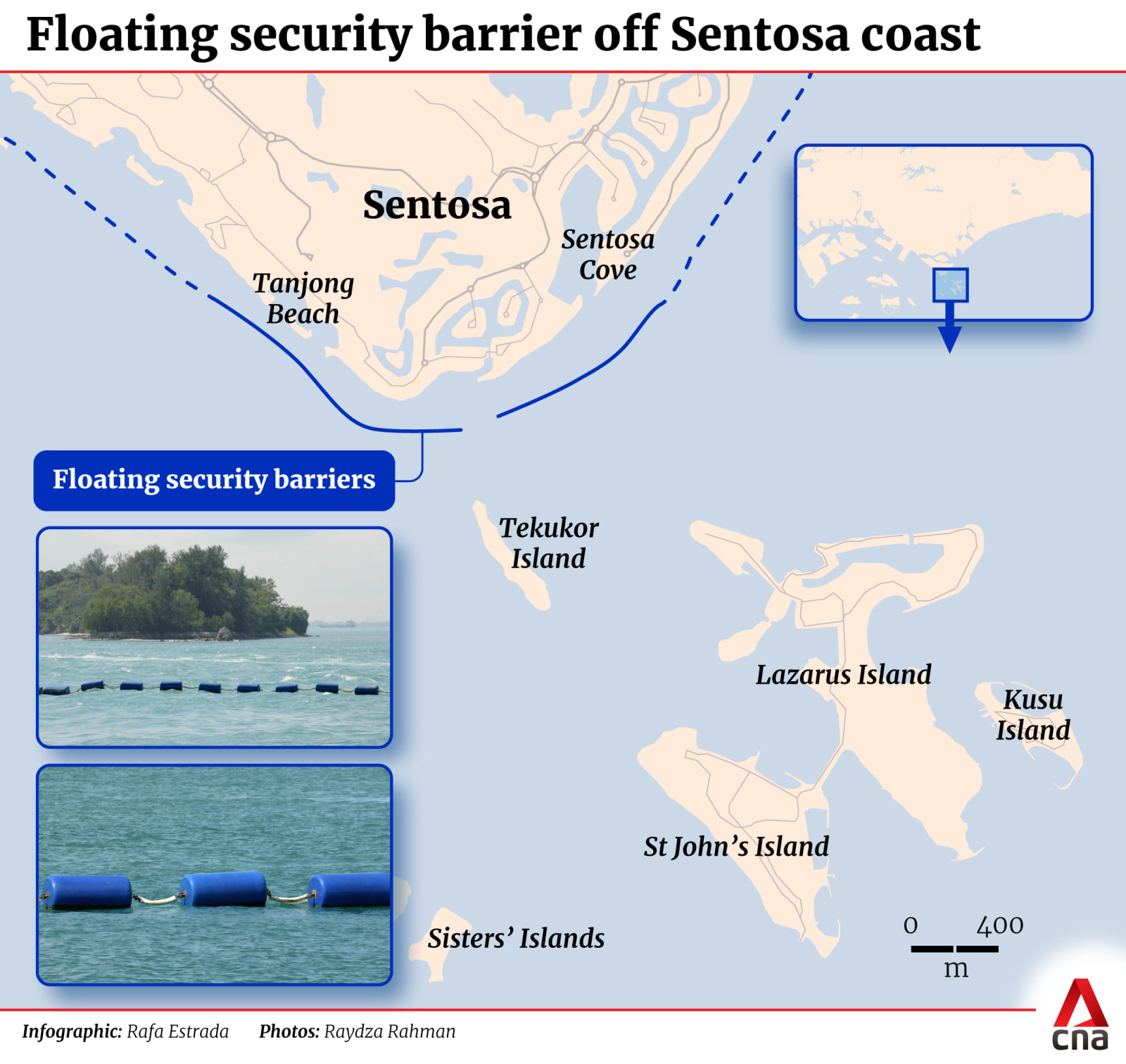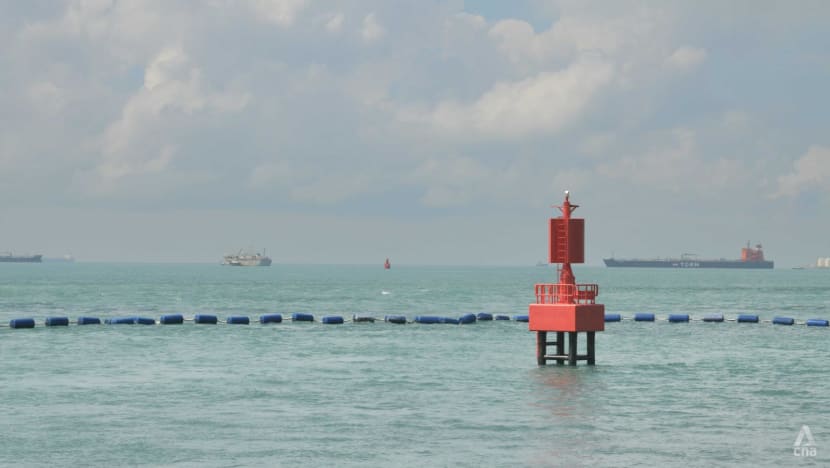Call for safety measures, changes to floating barrier after fatal kayak accident off Sentosa
More can be done to make the waters at the “notorious” spot safer, kayakers say.

The floating barrier off Singapore's Sentosa Cove on Oct 25, 2023. (Photo: CNA/Raydza Rahman)

This audio is generated by an AI tool.
SINGAPORE: Notorious, treacherous, a “washing machine” – this is how some kayakers have described the waters at the southern tip of Sentosa where a kayaker capsized and died.
Ms Chew Jia Tian, 33, who went out kayaking with friends in that zone, capsized and went missing on Oct 22. Her body was found off Sentosa two days later.
In the wake of the accident, kayakers who frequent the area told CNA that it is especially tricky to paddle there.
The difficulty navigating the fast-moving currents is compounded by having a blue floating security barrier surrounding the area, which can be a hazard for inexperienced paddlers.
These security barriers have been installed around Singapore since 2014 and are part of measures to secure Singapore’s coast. They help to deter potential intrusions by high-speed craft and illegal immigrants, the police coast guard was quoted as saying in a Straits Times report in 2020.
The stretch along Sentosa coast was added around 2020.
Water sports operators on Sentosa said that the barrier does not pose a problem in calmer waters, but from Tanjong Beach heading to the Southern Islands, the currents in that channel can be strong and unpredictable.
Mr Sim Cher Huey, founder of KayakAsia, said: “Many incidents have happened at the exact same area. It’s a hazard for inexperienced paddlers and those without proper safety equipment or knowledge of currents.”

Mr Mervin Low, a kayak fishing enthusiast, said the narrow channel between the islands funnels tonnes of water through, resulting in fast and strong currents, making the waters there one of the most challenging in Singapore to navigate – even without the floating barrier.
There are also whirlpools, which kayakers and divers refer to as “washing machines”.
“The underwater terrain of multiple ‘rises and falls’ in depth causes whirlpools to form and randomly deflect current directions, according to the strength of the current. Hence, it is very challenging, especially for non-powered vessels such as kayaks and stand-up paddles,” he said.
The barrier makes it even harder for paddlers by restricting their ability to ride the current, he said. Mr Low explained that with the blue barrels in place, kayakers do not have enough time and space to correct their direction and manoeuvre away from potential whirlpools.
"PUSHED AGAINST THE BARRIER"
Several people who have capsized at the barrier or rescued people from there have uploaded videos online with their first-hand accounts.
In one YouTube video from 2020, a kayaker describes how he was pushed against the barrels by the current and could not free himself. He was then sucked under the floating barrels and drifted out to sea for about 30 minutes before being picked up by a boat.
According to Mr Aaron Ang, CEO of kayak fishing tour company Fever.sg, paddlers capsize there at least once every two months.
Kayak fishing enthusiast Mr Low said inexperienced paddlers may run into trouble due to their inability to "read the waters".
“As the barrier is floating, water will push or force any object under it. The kayaks will be pushed on the broadside, making it very unstable in the situation … one will be struggling to stay upright.”
Once the kayak capsizes, the barrier does not give the paddler time and space to recover, he said.
“The capsized (person) may be pushed against the barrier that may be laden with sharp barnacles, making a self-recovery almost impossible, without going under and reorganising on the other side (of the barrier),” he said. “His or her buddy will be helpless as they are separated by the barrier.”
Mr Low said he raised these and other concerns with the police coast guard at a mariners' meeting a few years ago as a community representative for the kayak anglers. He and others in the community have continued to provide feedback to the coast guard and the Maritime and Ports Authority (MPA), he added.
Interviewees also said that the floating barrels can be a hindrance during emergencies. While there are openings through the barrier, they are several hundred metres apart.
Mr Ang said that if one was caught out at sea with a problem and needed to evacuate to shore, the time required to paddle back to safety is extended by the need to circumvent the barrier and get to an opening.
“Without the barrier, it could be a five-minute paddle to the nearest safe landing point, but with the barrier, the distance to a barrier opening could be 20 to 30 minutes away, plus another five minutes to shore. In a lightning alert situation or medical emergency, that could be life and death.”
He added that if the current was strong, a kayaker would paddle as close to shore as possible as the current is weakest there but if one was outside the barrier, that is not possible.
Kayakers also said that rescue options are limited, and most who capsized there were rescued by passing private boats or other watercraft. MPA and coast guard vessels are “too big and cumbersome” to help with any rescue should one be pinned at the barrels, said Mr Low.
“They have made some changes recently to the barrier positioning but it is not enough,” he said. “It’s a balance between national interests and community interests. The social cost of the installation outweighs the benefits at Sentosa area due to the elements.”

MOST USERS ABLE TO NAVIGATE AROUND BARRIERS: CANOE FEDERATION
The Singapore Canoe Federation said it had discussions with the authorities in 2021 about the position of the security barrier, which "led to a more favourable alignment".
"Although there have been incidents of collision with the security barriers, most sea space users are able to navigate around them without incident," the federation said.
Veteran kayakers had suggestions on how to make the area safer. Mr Sim proposed that the blue barriers can be aligned with the direction of current flow, so it does not become a “trap”. They could also be aligned closer to the shore, outside the flow of the current.
It would help if there was another opening at Tanjong Beach, where many kayakers launch from, so they do not need to paddle within the blue barriers to get to existing openings outside Sentosa Cove.
The Singapore Paddle Club advised those paddling around Sentosa and the Southern Islands to take precautions as the currents in the area can be challenging due to the topography of the area.
"If you are not a proficient paddler, stay within calmer waters near the shoreline between Siloso beach and Tanjong beach. Even if you are a proficient paddler, should you intend to paddle in any unfamiliar area, it is safer to be accompanied by (someone) with an in-depth understanding of the environment, navigation marks and obstacles there," said the club's president Ng Daojia.
"We encourage the use of common sense and caution when planning your paddle. Water-based activities can be carried out safely with sufficient education, awareness and preparation."

















